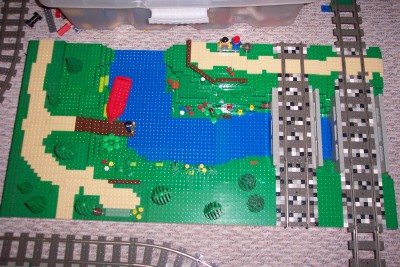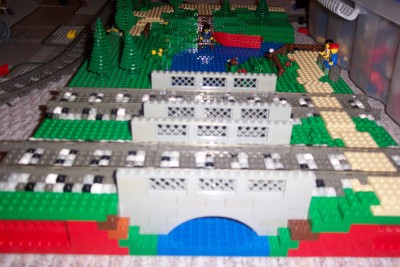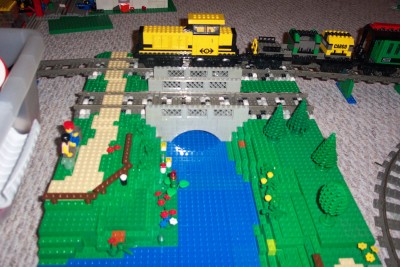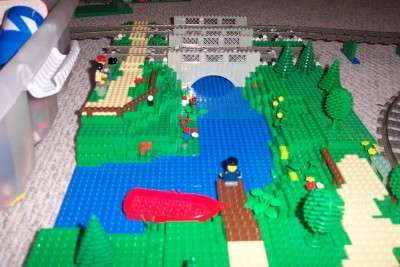
Brickscaping - A Landscape in LEGO
Die deutsche Version dieser Seite befindet sich hier...
I wanted to do this so many times - and there are some historical photographs to prove that I made some attempts in this direction - however I never managed to achieve what I had in mind... until now:
What I am going to show here for the first time is my attempt at what is commonly known as "brickscaping" - a modular landscape consisting entirely of LEGO bricks.
Why modular?
One of the main issues with large scale modeling in LEGO is removal of the finished objects - either for storage or the occasinal presentation at meetings.
The common solution for big buildings is, to plan for un- and remountable blocks which can be stored separately. For brickscaping, the logical solution must be to define a standard size for pieces that can be put together or taken apart when necessary.
The footprint of "my design" is the size of two large building baseplates (48*48 studs each). This size is as practical as it gets because it can be achieved by assembling smaller plates (if I happen to run out of large plates), and with some careful construction a certain level of ruggedness is maintained, so modules can be stored or carried fairly easily. I quickly tossed the idea to use 4 baseplates in square (96 studs squared) after crashing one of the first trial versions when lifting it.
Before I go on, here a first view on the (almost) finished first module:

As you can see, this first attempt had two basic design ideas: I wanted to create a small park with a river, and it had to provide for some train tracks in order to integrate it with my train layout at a later stage.
The top view reveals that there are two small bridges in the "front" part of the moduls. The tracks are "point-compatible" at 8 studs apart. Had I chosen to build only one broader bridge, the result might have looked too monolithic. Also, the river meanders slightly, so the bridges are not entirely in line to begin with.

I apologize for the poor image quality - I didn't mean to screw up like that.However, I guess the basic idea becomes clear: The terrain is raised by several lines of bricks (5 in this case). In the front and back of the module, some technic bricks are etched in by one stud. Using technic pins and matching technic bricks, several modules can be affixed side by side. In order to keep them aligned on the long sides, I have integrated more technic bricks which will take more technic pins for alignment. The bars in the front and back will keep the modules from accidentally moving apart. If I ever happen to have enough modules to also attach some in the front or back, the technic bricks used for side-locking can take up enough technic pins to align with the new modules - however additional bricks or plates on top of the modules will be necessary to keep those modules from drifting away. I consider this a minor drawback.
Some details I'd like to add:
Although it is rather difficult to do this in LEGO, I have attempted to make the track bed look at least somewhat realistic. Luckily, I bought some of the LEGO mosaic sets when they were on sale - the several shades of gray make for some appearance of gravel between the ties. I raised the track by one plate to achieve a minimal "dam" - that's about as realistic as I figure I can get it - I have seen others do better, but I want to have things kid-safe just in case...

This small park has some sand-covered walkways. These follow the terrain and in one case even cross the tracks (Careful when that train approaches!). In the river bend, I have installed a landing stage for a boat or a fisherman to sit on (currently there's only a frustrated conductor there, probably watching the young lady on the other side who is dating his colleague...)

The second module currently in the works will contain the next part of the river bed, and there the walkways will be connected by a small wooden bridge (provided I have enough brown plates left). On the other side of the existing module, I plan to significantly raise the terrain in order to finally accommodate my railway bridge (which has been shown already). There will also be a new tunnel then - which means tons of bricks that I will have to buy.
The existing module is quite sturdy already since there are support walls criss-crossed under the green bricks and plates (of course using all the ugly old and used bricks). If I continue this way of construction, I will certainly run short of some types of bricks with the third module at the latest.